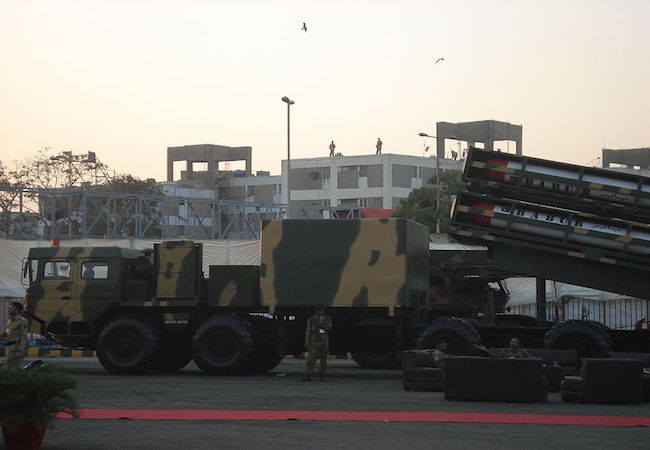
By Maimuna Ashraf
Nuclear pessimists and optimists are lately discussing the emergence of diverse portfolios of nuclear weapons in the South Asian context. Pessimist argue that the trend to develop a survivable nuclear force are further complicating the South Asian tension whereas the optimists view that the nuclear force structure establish a strengthened deterrence posture against rival. Nuclear force can be comprised of nuclear triad consisting three components land, air and sea based delivery systems. The sophisticated bombers for aerial system, technologically advanced ballistic missiles for land based missions and submarine/submarine launched ballistic missiles for the sea based delivery system. The rationale for acquiring a three-branched nuclear capability is to considerably decrease the possibility that an adversary could wipe out all of a country’s nuclear force structure in a first-strike attack; this, in contrary, provides a credible threat of a second strike and ensures a state’s credible nuclear deterrence. In nuclear strategy, “the second-strike capability is a country’s assured ability to respond to a nuclear attack with powerful nuclear retaliation against the attacker”. To acquire this capability and to convince adversary of its viability is considered imperative in establishing nuclear deterrence.
Here arises the question that why a state would go for sea-based capabilities when its land based missiles are able to cover its adversary? To understand this phenomenon that why sates adopt a certain assortment of nuclear weapons one must comprehend the policymakers’ decisions about the nuclear force structures. For instance, a state can acquire certain capabilities by possessing an individual nuclear platform because nuclear platforms vary in terms of range, destructive power, vulnerability to attack, effectiveness against different kinds of enemy forces, and other important attributes. Hence the acquisition of a particular nuclear platform is inadequate. In order to achieve the best state goals and assured deterrence, nuclear optimist believe that states must consider diversifying weapons and totality of nuclear capabilities by creating a portfolio of platforms.
According to nuclear scholars “diversification is advantageous for defensive reasons. Lacking experience with nuclear conflict, nations cannot know which weapons will prove most effective or most vulnerable on the battlefield. Emphasizing a particular nuclear platform increases the risk that nuclear forces will become vulnerable to enemy counterforce targeting or other measures or even to unforeseen or accidental logistical or maintenance problems. This is one of the fundamental justifications for the nuclear triad.” Furthermore, it is said by Former Secretary of the Air Force Thomas Reed, “diversity poses an insoluble targeting problem to any aggressor. Any attack that might seriously cripple one leg of the Triad constitutes a clear and unambiguous warning to the other two. There is no known way to attack all three simultaneously”.
Lately, after the successful test of nuclear-capable Babur-III SLCM from a submerged platform, Pakistan declared to achieve the second strike capability and stated it the ‘manifestation of the strategy of measured response to nuclear strategies and postures being adopted in its neighborhood’. Babur-III has been incorporated with the state of the art technologies that include sophisticated guidance system, highly advanced navigation features, and underwater controlled propulsion that would hit the target with defined accuracy. Moreover, stealth technologies like terrain hugging and sea skimming flight capabilities will dodge air defenses and radars in emerging South Asian landscape with India possessing Ballistic Missile Defense (BMD) while the sea-based mobile platform will keep it undetected. Conversely, the first successful flight test of Ababeel, after the two operational MRBMs Shaheen-I and Shaheen-II, would enable Pakistan to launch multiple warheads using Multiple Independent Re-entry Vehicle (MIRV) technology. This development placed Pakistan among few states, including US, China and Russia, to possess this technology. The development of the Ababeel weapon system was aimed at ensuring survivability of Pakistan’s ballistic missiles in the growing regional Ballistic Missile Defence (BMD) environment. Therefore, this development will augment Pakistan’s deterrence posture. These developments implies three evident and instant implications; first, it is likely to provide Pakistan a seaborne nuclear deterrent while India already possesses it after formally commissioning its nuclear powered submarine — INS Arihant. Second, since Indian BMD had reduced India’s vulnerability to Pakistani ballistic missiles strike, undercut Pakistan’s offensive posture yet strengthened India’s defensive capabilities therefore MIRV technology is an effective option to neutralize this development. Third, these developments stabilizes the status quo because when the strategic equilibrium is in play; the concept of mutual destruction functions and the nuclear opponents has reciprocal annulment of options for war at any level.
Another question that often surfaces against Pakistan is that if Indian nuclear submarine are aimed to deter China then why Islamabad would enter into a maritime nuclear race with New Delhi? The answer is in understanding that this sea-based nuclear deterrence transpired from the fright of being destroyed by a state possessing superior capabilities. Just like India is compelled to respond Chinese sea based nuclear developments so is Pakistan in case with India. Many analysts believe that a diversified nuclear force structure, covering each leg of nuclear triad, assure the credible second strike capability and mutual fears of destruction. Thus theoretically, completion of nuclear triad on both sides, Pakistan and India, assures credible second-strike capability, reduces the vulnerability of nuclear attack and help stabilize a nuclear relationship.




